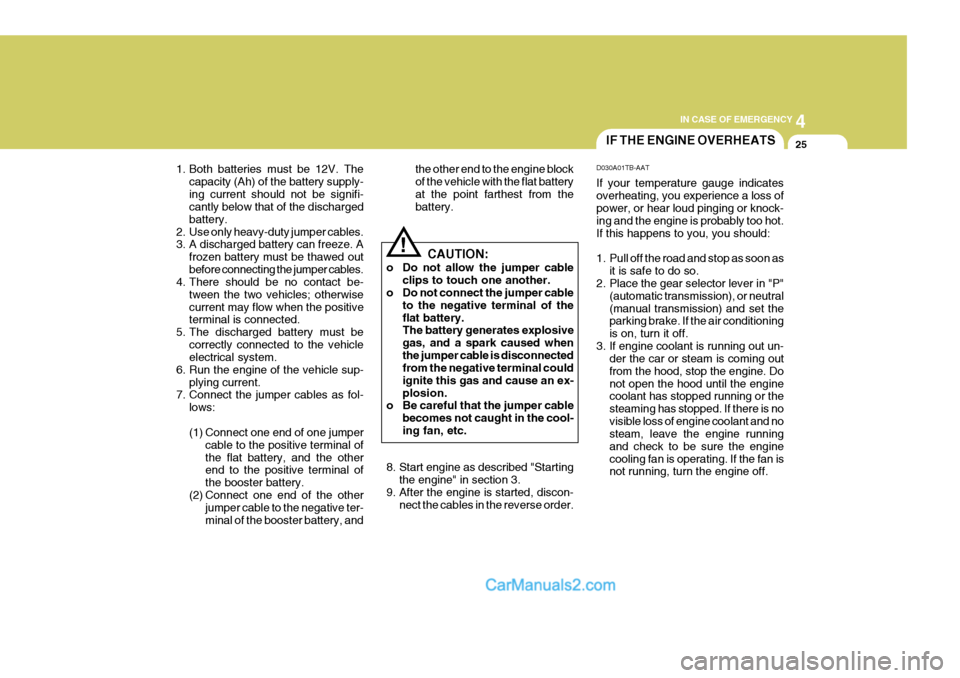2005 Hyundai H-1 (Grand Starex) coolant capacity
[x] Cancel search: coolant capacityPage 126 of 205

4
CORROSION PREVENTION AND APPEARANCE CARE
25
4
IN CASE OF EMERGENCY
25IF THE ENGINE OVERHEATS
CAUTION:
o Do not allow the jumper cable clips to touch one another.
o Do not connect the jumper cable
to the negative terminal of the flat battery. The battery generates explosive gas, and a spark caused whenthe jumper cable is disconnected from the negative terminal could ignite this gas and cause an ex-plosion.
o Be careful that the jumper cable
becomes not caught in the cool-ing fan, etc.
! D030A01TB-AAT If your temperature gauge indicates overheating, you experience a loss of power, or hear loud pinging or knock- ing and the engine is probably too hot.If this happens to you, you should:
1. Pull off the road and stop as soon as
it is safe to do so.
2. Place the gear selector lever in "P"
(automatic transmission), or neutral (manual transmission) and set the parking brake. If the air conditioning is on, turn it off.
3. If engine coolant is running out un- der the car or steam is coming outfrom the hood, stop the engine. Donot open the hood until the engine coolant has stopped running or the steaming has stopped. If there is novisible loss of engine coolant and no steam, leave the engine running and check to be sure the enginecooling fan is operating. If the fan is not running, turn the engine off.
the other end to the engine block of the vehicle with the flat batteryat the point farthest from the battery.
8. Start engine as described "Starting the engine" in section 3.
9. After the engine is started, discon- nect the cables in the reverse order.
1. Both batteries must be 12V. The
capacity (Ah) of the battery supply- ing current should not be signifi- cantly below that of the discharged battery.
2. Use only heavy-duty jumper cables.
3. A discharged battery can freeze. A
frozen battery must be thawed out before connecting the jumper cables.
4. There should be no contact be-
tween the two vehicles; otherwisecurrent may flow when the positive terminal is connected.
5. The discharged battery must be correctly connected to the vehicleelectrical system.
6. Run the engine of the vehicle sup- plying current.
7. Connect the jumper cables as fol-
lows:
(1) Connect one end of one jumper cable to the positive terminal of the flat battery, and the other end to the positive terminal of the booster battery.
(2) Connect one end of the other jumper cable to the negative ter-minal of the booster battery, and
Page 181 of 205

8DO-IT YOURSELF MAINTENANCE
12
!
4. Turn the radiator cap counterclock-
wise without pressing down on it, until it stops. This relieves any pres- sure remaining in the cooling sys- tem. And remove the radiator capby pushing down and turning coun- terclockwise. Now fill the radiator with clean dem- ineralized or distilled water. Con- tinue to add clean demineralized or distilled water in small quantitiesuntil the fluid level stays up in the radiator neck.
5. Start the engine, top off the radia- tor with water and then add engine coolant to the reservoir until thelevel is between "L" and "F".
6. Replace the radiator and reservoir caps and check to be sure thedrain cocks are fully closed and not leaking. WARNING:
The cooling fan is controlled by
engine coolant temperature andmay sometimes operate even when the engine is not running. Useextreme caution when working near the blades of the cooling fan so that you are not injured by a rotat-ing fan blade. As the engine cool- ant temperature decreases, the fan will automatically shut off. This isa normal condition.
G050D02P-AAT To Change the Coolant The coolant should be changed at those intervals specified in the ve- hicle maintenance schedule in Sec- tion 6.
!
CAUTION:
Engine coolant can damage the finish of your car. If you spill en-gine coolant on the car, wash it off thoroughly with clean water.
1. Park the car on level ground, set the parking brake and remove the radiator cap when cool.
2. Be sure your drain receptacle is in
place. Open the drain cock on theradiator. Allow all the engine cool- ant to drain from the cooling sys- tem, then securely close the draincock.
3. Check Section 9 for the capacity of the cooling system in your car.Then, following the manufacturer's directions on the engine coolant container, add the appropriatequantity of coolant to the radiator.
Page 202 of 205

10
INDEX
3
D
DAY/NIGHT INSIDE REARVIEW MI RROR .............2-34
DEFROSTING/DEFOGGING ...................................2-43
DIGITAL CLOCK ...................................................... 2-37
DOOR LOCKS .......................................................... 1-12
DRINK HOLDER ....................................................... 2-35
DRIVING FOR ECONOMY ......................................3-25
DRIVING WITH ELECTRONIC DUAL-RANGE AUTOMATIC TRANSM ISSION ............................. 3-13
EEMISSION CONTROL SYSTEM ............................... 7-2
ENGINE ...................................................................... 9-3
ENGINE COMPARTMENT ......................... ................ 8-2
ENGINE COOLANT .................................................. 8-10
ENGINE COOLANT TEM PERATURE GAUGE.......2-12
ENGINE NUMBER ..................................................... 1-5
ENGINE OI L ............................................................... 8-7
ENGINE RPM ADJUSTMENT KNOB ......................2-24
EXPLANATION OF SCHEDULED MAINTENANCE ITEMS .............. ...........................6-12
FFOUR-WHEEL DRIVE (4WD) ..................................3-15
FRONT DOOR EDGE WARNING LIGHT ...............2-25
FRONT DOOR WINDOW GLASS ...........................1-25
FRONT FOG LIGHT SWITCH .................................2-25FRONT/REAR WINDOW DEFROSTER
SWITCH .. 2-26
FUEL GAUGE ........................................................... 2-12
FUEL TANK CAPACITY ............................................. 9-2
FUSE PANEL DESCRIPTION ..................................4-40
GGENERAL CHECKS ................................................... 8-6
GOOD BRAKING PRACTICE ..................................3-22
HHAZARD WARNING SYSTEM................................ 2-26
HEADLIGHT AIMING ADJUSTMENT ......................4-29
HEADLIGHT LEVELING DEVICE SYSTEM ............2-23
HEADREST ............................................................... 1-37
HEATING AND COOLING CONTROL ....................2-38
HEATING CONTROLS ............................................. 2-42
HEIGHT ADJUSTABLE FRONT SEAT SHOULDER BELT ...................................................................... 1-41
HIGH-MOUNTED REAR STOP LIGHT ...................2-25
HOLD OPEN LOCK SYSTEM................................. 1-13
HOOD RELEASE ..................................................... 1-23
HORN ........................................................................ 2-37